Gauguin and the Impressionists: Masterpieces from the Ordrupgaard Collection at the Royal Academy

In 1916, the bloodiest year of the Great War which saw the battles of Verdun and the Somme, an insurance magnate from neutral Denmark started collecting some of the finest French paintings dating back to the 1830s. The conflict presented Wilhelm Hansen and his wife Henny with an opportunity to acquire works from Parisian galleries like Galerie Durand-Ruel at significantly reduced prices. By the end of the 1920s, the couple had amassed one of the most impressive collections of Impressionist paintings outside of France. In 1918, they decided to open Ordrupgaard, their house near Copenhagen, and all of their collection to the public. Henny bequeathed the property and its artistic treasures to the Danish nation in 1951, and two years later it was transformed into a museum.
The present exhibition at the Royal Academy, Gauguin and the Impressionists: Masterpieces from the Ordrupgaard Collection, is showing 60 of the French works gathered by the Hansens. Nearly half of the paintings featured are appearing in these shores for the first time, on something of a world tour while the Ordrupgaard museum is enlarged. The title chosen by the Royal Academy, whilst certainly whetting the appetite, cannot be said to encompass everything assembled here. However, the opening room is indeed devoted to landscapes, seascapes and cityscapes produced by Impressionists painters en plain air. Hansen persuaded the French art critic Theodore Duret, an early supporter of the Impressionists, to help him build his French collection. Since first visiting Paris in 1893, the Dane had been to the Salon on numerous occasions, but by the time he made his first French art acquisitions (two Sisleys, a Pissarro, a Monet and a Renoir) he was already 48.
Everywhere in the opening room, there are paintings bursting with light and energy. This show begins with sundrenched scenes by Camille Pissarro such as Morning Sun in the Rue Saint Honore, Place du Theatre Francais (1898). There are several paintings by Alfred Sisley of the Seine, imbued with calm. Elsewhere, you can find a lively sketch by Pierre-Auguste Renoir for his Le Moulin de la Galette (1875-76), familiar to any visitor of the Musee d’Orsay. One sees Pissarro and Monet reflecting on the light and hustle and bustle of the modern metropolises of Paris and London in Rue Saint-Lazare, Paris, 1897 and Waterloo Bridge, Overcast (1903). In the latter, painted during Monet’s second spell in London, the artist is capturing the city’s changing light through the distinctive fog to which he was drawn.
Entitled Collecting French Masters, the second room strikes a different chord. This gallery has been arranged as a reproduction of the original hang at Ordrupgaard of the work of 19th-century painters, many of whom can be viewed as precursors of Impressionism. There are works here by Delacroix, Ingres and Corot, as well as a dramatic painting by Realist Gustave Courbet, The Ruse, Roe Deer Hunting Episode (Franche-Comte) from 1866. The leaping deer have a rigid, fixed quality which makes them appear to be collaged onto the snow-carpeted background, rendered with a palette knife. Another painting by Delacroix depicts George Sand, one of the most popular novelists of her age, whose eyes are averted by some unseen spectacle. A substantial number of works by Jean-Baptiste-Camille Corot also appear in this second room. Hansen’s advisor Duret had been friendly with Manet, who extolled Corot as “the last of the classicists, the first of the moderns.” Corot’s The Windmill (1835-40) is a small, rather striking landscape. This Windmill, painted from the region around Versailles, has a directness of expression which suggests it might have been created on the spot.
Towards the end of the 1910s, the Hansens started to address the lack of works by women artists in their growing collection, acquiring paintings by the Impressionists Berthe Morisot and Eva Gonzales. They feature in the third section of this exhibition alongside canvasses by Renoir, Manet and Degas depicting women. Morisot’s Woman with a Fan (Portrait of Madame Marie Hubbard) (1874) shows a friend of her mother’s reclining rather unconventionally on a daybed. The subject fans herself, her white dress and slippers rendered with a delightful lightness. It is thought to be a direct response to Manet’s reputation for erotically charged images of women; Madame Hubbard too meets the artist’s gaze, yet here the interplay is friendly and not hierarchical. One also finds a portrait by Degas here: Woman Arranging Her Hair (1894). It’s an unusual example of the artist using oil at this mature point in his career; he applies thin, pastel-like layers of paint, clearly concerned in the drama of the movement of this feminine ritual. In The Convalescent (Portrait of a Woman in White) (1877-78) the artist, Eva Gonzales similarly uses oil with the lightness of pastel, evoking the texture and form of the white dress with great subtlety. Woman in a Meadow (Lise Trehot) (c. 1868) is a spontaneous little oil study by Renoir of his lover and favourite model of the period, her outstretched dress seeming to merge with the grass.
Surely it’s the show’s closing room which provides most of the fireworks. At last, Gauguin makes an appearance in the form of eight superb paintings. One sees pivotal figures like Cezanne, Henri Matisse and Gauguin absorbing Impressionism and entering new ground. There’s much to catch the eye. In one corner is the Basket of Pears (1882) still life by Manet that was such a favourite of Wilhelm Hansen. Created in the last year of the artist’s life, the transience of the subject has been interpreted as the ailing Manet contemplating his own mortality. On the opposite wall are two considerably less sombre still lifes. Henri Matisse’s Flowers and Fruits (1909) is, at least chronologically, the most modern painting in the Hansens’ collection. The great Modernist is carefully balancing his composition, the vivid colours of the vase of flowers and fruit set against a gridlike background. Positioned next to the Matisse, Still-Life (1901) by Symbolist artist Odilon Redon plays with complementary hues of blue, gold and orange, crackling with energy. Another major figure in the evolution of modern art, Paul Cezanne also appears in the final room. He exhibited with the Impressionists in 1874 but in time took his own path. Women Bathing (c. 1895) is a late period work as evidenced by the cool palette and watercolour-like application of paint. Instead of using life models, he took figures from other paintings, photographs and reproductions of nudes from the Louvre.
Few would argue, though, that the highlight of this exhibition is the remarkable group of works by Gauguin. It has been suggested that some of Wilhelm Hansen’s enthusiasm for this artist can be put down to the Frenchman having a Danish wife. In 1916, the collector would buy Gauguin’s The Little One is Dreaming, Etude from his widow, Mette. This tender 1881 portrait of Gauguin’s child was exhibited in the seventh Impressionist Exhibition of 1882. In 1922, the Danish Landmandsbank collapsed and consequently Hansen was forced to sell some of his collection but he pointedly kept all of his Gauguins. Blue Trees (Your Turn Will Come, My Beauty!) (1888) is a dramatic landscape painted in Arles during that productive but tension-filled stay with Van Gogh. The four cobalt blue tree trunks soar beyond the confines of the canvas from a complementary orange foreground, instantly recalling the Japanese wood engravings that fascinated both men.
In 1891, Gauguin took the decision which has shaped his reputation as an artist and human being ever since, choosing to travel to the Polynesian island of Tahiti, then a French colony, where he hoped to find a kind of primitive paradise. Today it is widely known that the artist exploited his position and power to take advantage of adolescent girls in Tahiti: he would marry three, despite already having a wife, and father several children by them. With issues surrounding gender, race and colonialism increasingly in the public consciousness, museums around the world are having to reassess the artist’s legacy. Exhibition curator Anna Ferrari hopes that despite their differing reactions, people will engage with the work while understanding his problematic history.
Gauguin’s Portrait of a Young Woman. Vaïte (Jeanne) Goupil (1896) was painted on Tahiti. Clearly a Symbolist painting, vivid pink and blue make for a strong background to the pale-skinned figure, her red lips giving her the impression of being older than her 9 years. The subject, daughter of French lawyer, journalist and politician Auguste Goupil, wears a missionary dress, alluding to Gauguin’s ambivalent attitude towards colonialism. Two other paintings here depict indigenous Polynesian women. Tahitian Women (1898) features two Tahitian women bathing. One sits languorously on the shore whilst her companion walks into the sea, steadying herself on a tree branch. Gauguin has used intoxicating reds and greens. It’s an image of tropical eroticism.
A final Gauguin brings this memorable exhibition to a conclusion. Adam and Eve (1902) recalls traditional images of the biblical narrative by the likes of Cranach and Durer. Eve, depicted as a Polynesian woman with cloth in hand ready to cover her shame, stands in the centre; young, strong and pure. Adam’s brown hair and beard, by contrast, mark him out to be European and possibly even a Gauguin self-portrait. He faces sideways, head bent, already despairing of the imminent loss of innocence. One interpretation is that the artist is delivering a critique of how colonialism is laying waste to Polynesian culture. Others believe this to be Gauguin turning away from Paradise as he senses his own end approaching. It’s a sombre note to end what is largely a hugely uplifting exhibition. Gauguin and the Impressionists offers a rare opportunity in this country for gallery-goers to view some of the highlights of this impressive collection.
James White
Featured Image: Detail from Portrait of a Young Girl (Vaïte ‘Jeanne’ Goupil), Gauguin, 1896
© Ordrupgaard, Copenhagen
Gauguin and the Impressionists: Masterpieces from the Ordrupgaard Collection is at the Royal Academy Wednesday to Sunday from 7th August until 18th September 2020. For further information or to book visit the exhibition’s website here.

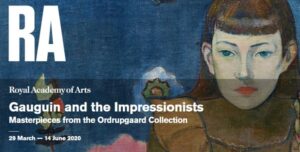
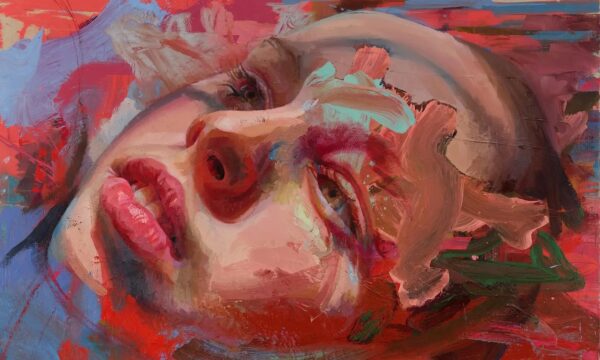

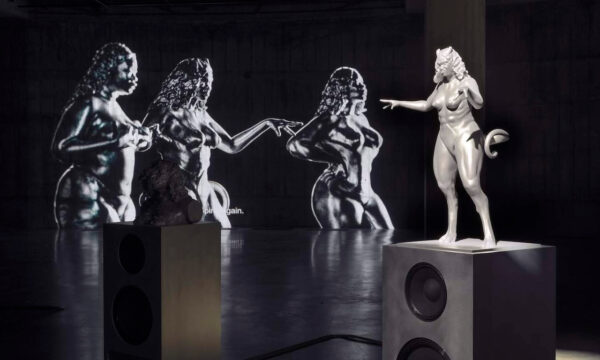
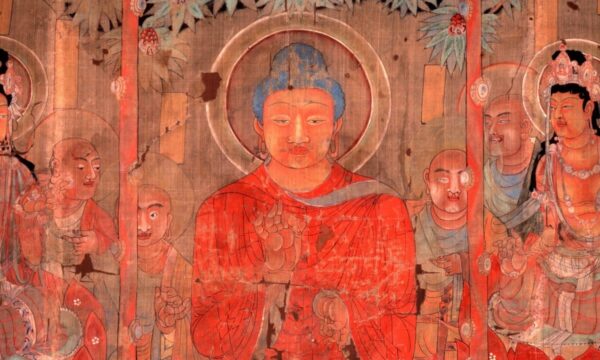



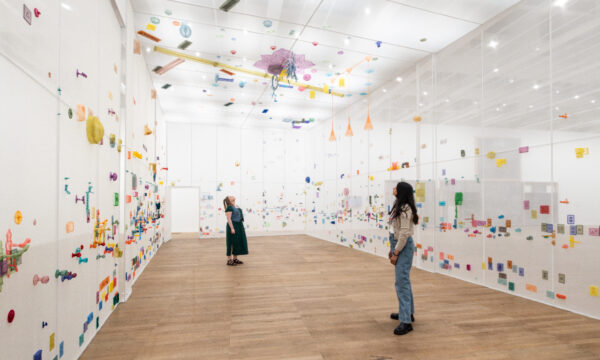
















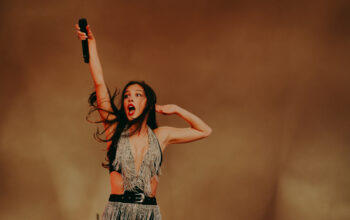
Facebook
Twitter
Instagram
YouTube
RSS